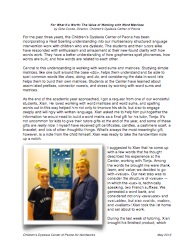Copyright Susan and Peter Bowers 2008

For What Itʼs Worth:
The Value of Working with Word Matrices
Gina describes a moving story about Xian, a student who has just graduated from a Children’s Dyslexia Center. All literacy educators, but especially those that work with struggling students can learn a great deal from Xian.
Xian expertly expresses how working with matrices and word sums made sense of English spelling for him, and thus allowed him to take control of this system that used to defeat him. His message to his tutors is not just a thank you note. His message itself is in the form of evidence of the control he has gained over English spelling, and the pride and empowerment that comes with this knowledge.
If we are wise enough to listen, Xian has an important lesson to teach all literacy educators, especially those who work with students who struggle with reading and writing.
Matrices in the classroom

The work and faces of the students in these images tell us about the results of their learning.
Because a lot of the international schools I work with use Understanding by Design I have been helping schools understand how this instruction ties into that curriculum’s use of a principle they call “backwards design”. They define backwards design as, “[an] approach to designing a curriculum or unit that begins with the end in mind and designs toward that end.” (Wiggins and McTighe, (2005, p. 338). I would say that the images and stories on this page provide clear evidence of the kinds of ends literacy instruction should seek.
See structured word inquiry lessons on <know> that informed the lessons in Tam’s class here.
Students from Tam Tam Truong’s class at the International Schools Riau, in Sumatra show of what they know about English spelling with pride!



